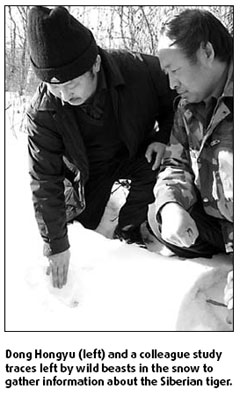Why Dong has an eye for the tiger

Dong Hongyu's hands bear the scars of his life's passion and reveal the dangers he faces in his unusual line of work. The 42-year-old used to hold a hunting license and enjoyed shooting rabbits and pheasants, but he put his weapon down a long time ago.
Today, the head of the supervisory center in Wupao Forestry Bureau, in Heilongjiang province, tries to save wildlife rather than destroy it.
But the scars on his hands and elsewhere are not the result of all those shooting trips. Instead, the marks were the result of an attack by hunters.
In Nov 2006, four angry poachers he stopped later came to his home, and attacked him with iron bars and beer bottles. Dong was hospitalized for 12 days and his wife begged him to stay out of danger. But only a few months later, during the Spring Festival, he was back to work clearing more than 50 snares and intercepting two poachers and nine hunting dogs.
Dong doesn't mind being called an "idiot" or even being misunderstood by his own wife. He is proud of his work and is especially proud of his work protecting the rare Siberian tiger.
Over the past two decades he has helped experts prove that China has some 20 wild Siberian tigers. Approximately 6 of them roam the wilds of Heilongjiang.
Last month, Dong won a prestigious award from The Wildlife Conservation Society (WCS), a conservation organization based in the United States. The award was titled: "Guard of Wildlife around the Border of China".
His passion for the Siberian tiger began 20 years ago during a field survey. He was accompanying experts from the provincial Wildlife Research Institute and chanced upon footprints that appeared to be of a tiger.
Official reports had ruled out the existence of wild Siberian tigers in the area so Dong was "surprised and thrilled by the discovery".
In the mid-1990s, the Chinese media shone the spotlight on the fate of the Siberian tiger and Dong took it upon himself to safeguard the endangered species.
He printed leaflets and paid up to 200 yuan to anyone who found evidence of the tiger. He would journey to these remote locations and take photos of the prints, all on his own coin.

One of the biggest threats to the tiger is always the poacher's snare and in 2000, a snare trapped and killed a tiger. This incident forced Dong to double his resolve.
Once he drove more than 300 km on the frozen Wusuli River to a location where people had reported seeing a tiger.
Local fishermen were shocked to hear that Dong had traveled on the icy river, which is covered with hidden ditches that trap vehicles. Even the locals were terrified to travel on the river in winter.
But Dong's gamble was fruitful because he later found tiger prints.
Not everything runs smoothly in Dong's tracking adventures.
Once Dong had to drive three hours and than had to hire a tractor to plough through the deep snow. Finally he had to walk for another hour to find traces of the Siberian tiger.
The footprints were clear and kept well. Dong was thrilled and busied himself measuring them. But he forgot to keep the gesso plaster material wet, and was unable to make a copy of the tracks.
Dong had to hire someone to bring new gesso. But after he secured the prints, he was happy.
Sometimes there are cases of mistaken identity. Once he hurried to a spot at 5 am only to find that the animal tracks were those of a black bear.
"Though disappointed, I still paid the villager, encouraging him to keep trying," he says.
The supervisory center under Wildlife Conservation Society was officially established in 2005 but the body receives little funding.
Dong says he has spent tens of thousands of yuan of his own money getting information and traveling to remote locations.
"Some think I must have profited from it, or I must be an idiot," Dong says.
"But I'm just obsessed with the work I'm doing my wife still supports me."
(China Daily 01/05/2009 page8)








